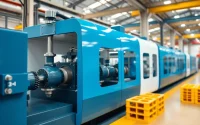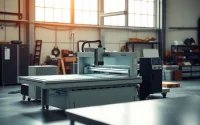Essential Guide to Nitrogen Regulators: Types, Uses, and Selection Tips
Understanding Nitrogen Regulators
What is a Nitrogen Regulator?
A nitrogen regulator is an essential component used to control the pressure and flow of nitrogen gas from a storage cylinder to various applications or tools. By regulating the flow and reducing the high pressure of nitrogen stored in gas cylinders, these regulators ensure a consistent and safe supply of nitrogen for various applications, ranging from beverage dispensing to industrial processes and HVAC systems. The primary purpose of a nitrogen regulator is to enable users to maintain optimal pressure and flow rates suited for their specific needs.
Key Features of Nitrogen Regulators
Nitrogen regulators come equipped with several key features that enhance their functionality and ease of use:
- Pressure Regulation: The primary function of a nitrogen regulator is to reduce the cylinder pressure to a preset or adjustable outlet pressure.
- Flow Control: Many nitrogen regulators allow users to adjust the flow rate of nitrogen, ensuring it’s tailored to their application requirements.
- Durability: Made from robust materials, these regulators are designed to withstand high pressures and various environmental conditions.
- Safety Features: Proper nitrogen regulators come with gauges to monitor pressure levels, and some models include safety valves to prevent overpressure scenarios.
- Compatibility: Many nitrogen regulators are designed to work with standard gas connections, making them versatile for various setups.
How Nitrogen Regulators Work
The operation of a nitrogen regulator is relatively straightforward. When nitrogen gas is stored in a cylinder, it is under high pressure. The nitrogen regulator connects to the cylinder via a threaded connection, typically a CGA580 connector for standard nitrogen cylinders. Upon opening the cylinder valve, high-pressure nitrogen flows into the regulator.
The regulator’s internal mechanism (usually a diaphragm) responds to the incoming pressure and reduces it to the desired outlet pressure. The outlet gas then flows either to a specific application or a distribution system. Gauges on the regulator display both the cylinder pressure and the outlet pressure, allowing operators to monitor and adjust as necessary.
Types of Nitrogen Regulators
Single Stage vs. Dual Stage Regulators
Nitrogen regulators are categorized into single-stage and dual-stage types, each serving distinct applications and requiring different functionalities:
- Single Stage Regulators: These are straightforward designs that reduce cylinder pressure to a lower outlet pressure using a single internal mechanism. They are typically more compact and are perfect for applications where constant gas supply and pressure are less critical.
- Dual Stage Regulators: More complex, dual-stage regulators reduce pressure in two stages, ensuring better pressure stability. They are ideal for applications that require consistent pressure over time, even as the gas cylinder empties, making them popular in industrial settings.
Adjustable vs. Preset Regulators
The choice between adjustable and preset nitrogen regulators largely depends on the specific requirements of the user:
- Adjustable Regulators: These units allow users to manually set the desired output pressure, making them versatile for various applications. Adjustability is beneficial in scenarios where different pressure settings may be required over time.
- Preset Regulators: Designed with a fixed outlet pressure, these regulators ensure that nitrogen is delivered at a consistent pressure without user intervention. They are ideal for straightforward applications where pressure variations can cause issues.
Compact and Inline Nitrogen Regulators
Compact nitrogen regulators are a great choice where space constraints exist. They are smaller in size yet provide the necessary functionality. Inline nitrogen regulators allow for integration into existing gas distribution systems without taking up additional space. These are particularly useful in applications where space is at a premium, such as small laboratories or production lines.
Applications of Nitrogen Regulators
Nitrogen Regulators in HVAC Systems
Nitrogen regulators are commonly used in HVAC (Heating, Ventilation, and Air Conditioning) systems, primarily for pressure testing and flushing refrigerant lines. When nitrogen is used for pressure testing, it helps identify leaks and ensures the integrity of the system before refrigerants are introduced. Furthermore, when flushing systems, nitrogen assists in removing impurities, moisture, and residual refrigerants.
Use in Beverage Dispensing
In the beverage industry, nitrogen regulators play a vital role in dispensing drinks such as draft beer and nitrogen-infused coffee. The ideal pressure for dispensing varies between beverages; thus, adjusting the nitrogen pressure ensures optimal performance and taste. Consistent pressure delivery helps maintain the perfect balance of carbonation and flavor, which is crucial for customer satisfaction.
Industrial Applications of Nitrogen Regulators
Nitrogen is widely used in various industrial applications, including food packaging (to displace oxygen), chemical manufacturing (to control reactions), and welding (to produce an inert environment). Nitrogen regulators are essential in these processes, ensuring accurate pressure levels to achieve desired outcomes and maintain safety standards.
Choosing the Right Nitrogen Regulator
Factors to Consider When Selecting a Nitrogen Regulator
When selecting a nitrogen regulator, consider the following factors to ensure optimal performance:
- Application Requirements: Identify the specific needs of your application, including pressure range, flow rate, and gas type.
- Pressure Delivery: Understand whether you need a single-stage or dual-stage regulator based on the stability of pressure required over time.
- Adjustability: Decide if you need an adjustable or preset regulator based on your workflow and pressure variations.
- Materials and Construction: Select materials that can withstand your specific environment (e.g., corrosive gases or extreme temps).
Common Mistakes to Avoid
When selecting or using nitrogen regulators, avoid the following pitfalls to ensure safety and efficiency:
- Poor Sizing: Using a regulator that does not meet your flow or pressure needs can lead to performance issues or even system failures.
- Ignoring Compatibility: Ensure that the regulator is compatible with existing hardware and gas types.
- Neglecting Safety Standards: Always adhere to industry safety regulations and standards to avoid hazardous situations.
Expert Recommendations for Optimal Performance
Consultation with industry experts or manufacturers when selecting and implementing nitrogen regulators can greatly enhance performance. Look for units that offer easy maintenance, clear gauge visibility, and reliable performance metrics. Regular training for staff using the regulators can minimize user errors and ensure that the equipment is used effectively.
Maintenance and Troubleshooting
Regular Maintenance of Nitrogen Regulators
Maintaining nitrogen regulators is vital for ensuring their longevity and reliability. Regular checks should include:
- Inspecting for leaks at connection points.
- Cleaning or replacing filters as needed to ensure unobstructed flow.
- Calibrating gauges to maintain accurate readings.
- Checking for wear and tear on critical components, such as diaphragms and safety valves.
Common Issues and Solutions
Some common issues that may arise with nitrogen regulators include:
- Pressure Drops: This might indicate a blockage or a failing diaphragm. Troubleshooting involves checking the entire flow path for obstructions.
- Leaking Connections: If pressure readings fluctuate, inspect all fittings and seals, tightening or replacing them as necessary.
- Inconsistent Flow: Adjusting the regulator settings or replacing damaged components may resolve this issue.
When to Replace Your Nitrogen Regulator
Indicators for replacing a nitrogen regulator may include:
- Constant pressure fluctuations that cannot be adjusted.
- Visible physical damage or corrosion that inhibits safe operation.
- Frequent leaks or performance failures despite maintenance efforts.
In summary, understanding nitrogen regulators involves delving into their operational mechanics, types, applications, selection criteria, and maintenance practices. For those in need of reliable pressure control for nitrogen gas, selecting the right regulator will directly impact performance across various applications, ensuring safety, efficiency, and optimal results. Whether for a nitrogen regulator in HVAC, beverage dispensing, or industrial use, it’s crucial to make an informed choice to guarantee reliability and effectiveness.


